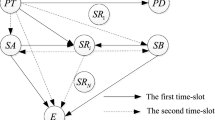Abstract
Cooperative relaying is an effective technology to improve the secrecy capacity of physical-layer (PHY) security. Multiple relays can help further exploit the spatial diversity of cooperative networks. In power-limited networks, relay selection scheme is crucial important for it determines whether the optimal relay combination can be selected. This paper studies the problem of multi-relay selection in amplify-and-forward compressed sensing (AF-CS) networks, in which relays help all sources amplify and forward the signal, and the transmission matrix is used as the measurement matrix to encrypt the information. A self-organizing algorithm based on stochastic learning automata (SLA) is proposed for the AF-CS network to look for the best relay combination in a self-learning and self-optimizing way, and named “learning-based multi-relay selection algorithm” (L-MRS). In L-MRS, the destination node is self-optimizing to select the best state autonomously, and relays are self-organizing to decide whether to join the cooperation or not according to the environment feedback. Simulation studies verify the L-MRS’s is able to select the optimal relay-combination in a very stable way, and can get higher secrecy capacity compared with the coalition formation game method.







Similar content being viewed by others
References
Khodakarami, H., & Lahouti, F. (2012). Link adaptation for physical layer security over wireless fading channels. IET Communications,6(3), 353–362.
Saad, W., Han, Z., Basar, T., Debbah, M., & Hjorungnes, A. (2009). Physical layer security: Coalitional games for distributed cooperation. In WiOPT 2009. 7th international symposium on modeling and optimization in mobile, ad hoc, and wireless networks, (pp. 1–8). IEEE.
Rachlin, Y., & Baron, D. (2008). The secrecy of compressed sensing measurements. In 2008 46th annual allerton conference on communication, control, and computing, (pp. 813–817). IEEE.
Barcelo-Llado, J. E., Morell, A., & Seco-Granados, G. (2014). Amplify-and-forward compressed sensing as a physical-layer secrecy solution in wireless sensor networks. IEEE Transactions on Information Forensics and Security,9(5), 839–850.
Fu, X., & Cui, Y. (2015). Multi-source and multi-relay cooperative system based on compressed sensing. Electronics Letters,51(22), 1828–1830.
Krikidis, I. (2010). Opportunistic relay selection for cooperative networks with secrecy constraints. IET Communications,4(15), 1787–1791.
Zhao, Y., Adve R., & Lim, T. J. (2006). Improving amplify-and-forward relay networks: optimal power allocation versus selection. In 2006 IEEE international symposium on information theory, IEEE.
Michalopoulos, D. S. (2006). Wlc41-1: An optimized user selection method for cooperative diversity systems. In Global telecommunications conference, GLOBECOM’06IEEE, IEEE.
Jing, Y., & Jafarkhani, H. A. (2008). Single and multiple relay selection schemes and their diversity orders. In ICC workshops’ 08. IEEE international conference oncommunications workshops, IEEE.
Zhang, Z., Song, L., Han, Z., & Saad, W. (2014). Coalitional games with overlapping coalitions for interference management in small cell networks. IEEE Transactions on Wireless Communications,13(5), 2659–2669.
Saad, W., Han, Z., Başar, T., Debbah, M., & Hjørungnes, A. (2011). Distributed coalition formation games for secure wireless transmission. Mobile Networks and Applications,16(2), 231–245.
Saad, W., Han, Z., Debbah, M., & Hjorungnes, A. (2009). A distributed coalition formation framework for fair user cooperation in wireless networks. IEEE Transactions on Wireless Communications, 8(9).
Bahbahani, M. S., Baidas, M. W., & Alsusa, E. (2015). A distributed political coalition formation framework for multi-relay selection in cooperative wireless networks. IEEE Transactions on Wireless Communications,14(12), 6869–6882.
Thathachar, M. A. L. (1990). Stochastic automata and learning systems. Sadhana,15(4–5), 263–281.
Chen, Z., Lin, T., & Chunlin, Wu. (2016). Decentralized learning-based relay assignment for cooperative communications. IEEE Transactions on Vehicular Technology,65(2), 813–826.
Barto, A., & Anandan, P. (1985). Pattern-recognizing stochastic learning automata. IEEE Transactions on Systems, Man, and Cybernetics,15(3), 360–375.
de Lope, J., Maravall, D., & Quinonez, Y. (2013). Response threshold models and stochastic learning automata for self-coordination of heterogeneous multi-task distribution in multi-robot systems. Robotics and Autonomous Systems,61(7), 714–720. (Collective and Social Autonomous Robots).
Sharma, S., Shi, Y., Hou, Y., & Kompella, S. (2011). An optimal algorithm for relay node assignment in cooperative ad hoc networks. IEEE/ACM Transactions on Networking,19(3), 879–892.
Yang, D., Fang, X., & Xue, G. (2011). OPRA: Optimal relay assignment for capacity maximization in cooperative networks. In Proceedings of the IEEE ICC, (pp. 1–6).
Ding, C., et al. (2017). A game theoretic learning solution for distributed relay selection on throughput optimization. Wireless Networks,23(6), 1757–1766.
Baraniuk, R. G. (2007). Compressive sensing [lecture notes]. IEEE Signal Processing Magazine,24(4), 118–121.
Mayiami, M. R., Seyfe, B., & Bafghi, H. G. (2010). Perfect secrecy using compressed sensing. Mathematics.
Guo, J., et al. (2015). Information capacity and sampling ratios for compressed sensing-based SAR imaging. IEEE Geoscience and Remote Sensing Letters,12(4), 900–904.
Miller, Rob, & Trappe, Wade. (2012). On the vulnerabilities of CSI in MIMO wireless communication systems. IEEE Transactions on Mobile Computing,11(8), 1386–1398.
Sutton, R. S., & Barto, A. G. (1998). Reinforcement learning: An introduction. Cambridge: MIT Press.
Papadimitriou, G. I. (1994). A new approach to the design of reinforcement schemes for learning automata: Stochastic estimator learning algorithms. IEEE Transactions on Knowledge and Data Engineering,6(4), 649–654.
Author information
Authors and Affiliations
Corresponding author
Additional information
Publisher's Note
Springer Nature remains neutral with regard to jurisdictional claims in published maps and institutional affiliations.
Rights and permissions
About this article
Cite this article
Fu, X., Li, J. & Chang, S. Learning-based multi-relay selection for cooperative networks based on compressed sensing. Wireless Netw 26, 3069–3081 (2020). https://doi.org/10.1007/s11276-019-02034-2
Published:
Issue Date:
DOI: https://doi.org/10.1007/s11276-019-02034-2




